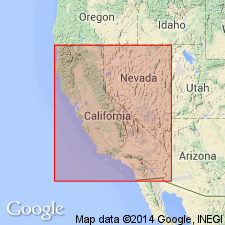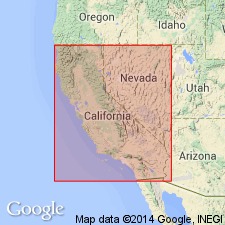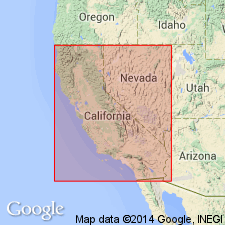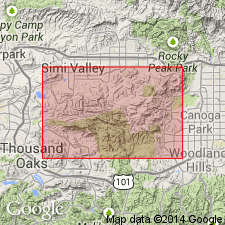
- Usage in publication:
-
- Santa Susana formation
- Modifications:
-
- First used
- Dominant lithology:
-
- Shale
- Sandstone
- AAPG geologic province:
-
- Transverse Ranges province
Summary:
Richard Nelson proposes to call formation in Simi Valley, Ventura Co, CA, Santa Susana formation. Previously mapped as part of Martinez. Consists largely of shale and shaly sandstone with heavy conglomerates in lower part. Is from 1000 to 1500 ft thick. Fauna is entirely different from that of underlying Martinez and has very little in common with unconformably overlying Meganos group.
Source: GNU records (USGS DDS-6; Menlo GNULEX).

- Usage in publication:
-
- Santa Susana shale
- Modifications:
-
- Named
- Biostratigraphic dating
- Dominant lithology:
-
- Sandstone
- Conglomerate
- AAPG geologic province:
-
- Transverse Ranges province
Summary:
Named for its proximity to town of Santa Susana, Ventura Co, CA. Occurs east of northwest-trending fault south of Simi Valley. Consists predominantly of light-gray shale with some fine-grained sandstone and lense of conglomerate in lower part toward its east end. Contains sporadic boulders of quartzite up to 6 in. Grades into underlying Martinez marine member (new) of Martinez group and into overlying Domengine formation. Molluscan fauna includes several distinctive genera, such as CORBIS and VELATES which are new to Eocene of CA. Age given as middle Eocene.
Source: GNU records (USGS DDS-6; Menlo GNULEX).

- Usage in publication:
-
- Santa Susana shale
- Modifications:
-
- Age modified
- Biostratigraphic dating
- AAPG geologic province:
-
- Transverse Ranges province
Summary:
Pg. 21 (fig. 4) shows age as [late] Paleocene through early Eocene.
Source: GNU records (USGS DDS-6; Menlo GNULEX).

- Usage in publication:
-
- Santa Susana Formation
- Modifications:
-
- Revised
- Biostratigraphic dating
- AAPG geologic province:
-
- Transverse Ranges province
Summary:
Gradational contacts of "Martinez marine member" of Nelson (1925) and eastward thinning of sandstone tongues into Santa Susana Formation indicate "Martinez marine member" represents shallow-water nearshore facies of Santa Susana Formation and does not merit formational rank. Combination of both microfossil and megafossil evidence indicates that lower sandy facies of Santa Susana Formation in Simi Hills is late Paleocene (Thanetian) in age.
Source: GNU records (USGS DDS-6; Menlo GNULEX).
For more information, please contact Nancy Stamm, Geologic Names Committee Secretary.
Asterisk (*) indicates published by U.S. Geological Survey authors.
"No current usage" (†) implies that a name has been abandoned or has fallen into disuse. Former usage and, if known, replacement name given in parentheses ( ).
Slash (/) indicates name conflicts with nomenclatural guidelines (CSN, 1933; ACSN, 1961, 1970; NACSN, 1983, 2005, 2021). May be explained within brackets ([ ]).

